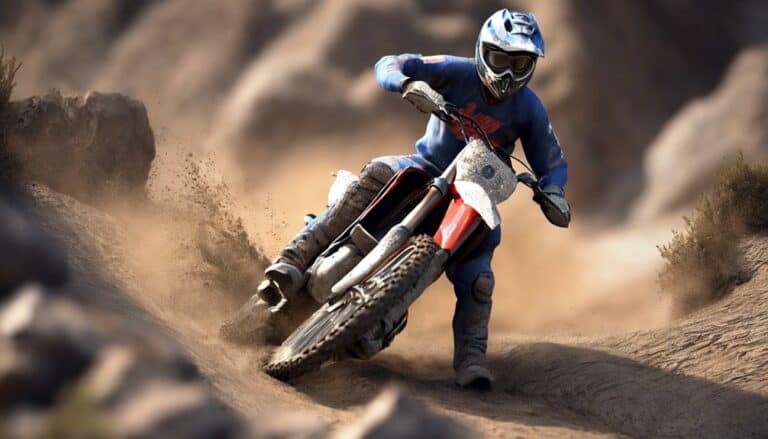When tackling various terrains on your dirt bike, mastering braking techniques becomes pivotal. From maneuvering rocky paths to slippery mud or sandy surfaces, each terrain demands a different approach to braking.
Uphill or downhill slopes add another layer of complexity, requiring precise control. Understanding how to adjust your braking strategy based on the terrain you encounter is key to ensuring a safe and successful ride.
But what specific techniques should you employ for each type of terrain?
Key Takeaways
- Rocky terrain requires precise braking control and strategic timing for descent.
- Wet surfaces demand adjusted braking techniques for reduced traction.
- Loose sand necessitates gentle pressure on both brakes to avoid skidding.
- Steep inclines benefit from controlled braking and balance of front and rear brakes.
Impact of Rocky Terrain on Braking
Traversing rocky terrain on a dirt bike requires precise braking control and strategic timing to overcome the challenges posed by the uneven surfaces.
When tackling rocky terrain, the key to effective dirt bike braking lies in mastering the art of modulation. Wheel slippage and loss of traction are common occurrences on these rugged surfaces, demanding a nuanced braking technique.
To navigate safely, riders must adapt their braking approach, considering the reduced grip and potential obstacles. Braking distances inevitably lengthen on rocky terrain as gradual deceleration becomes imperative for stability.
Proper weight distribution and body positioning are paramount in maintaining control during braking maneuvers. By shifting your weight intelligently and adjusting your body position to optimize traction, you can mitigate the risks of skidding and improve overall braking performance on rocky terrain.
Braking Challenges on Wet Surfaces
Handling wet surfaces on a dirt bike presents riders with heightened braking challenges due to reduced traction and increased stopping distances. When encountering wet terrain, adjust your braking techniques accordingly. To brake efficiently on wet surfaces, apply the brakes more lightly than usual to prevent wheel locking and skidding.
Focus on using both the front and rear brakes simultaneously to achieve a balanced braking effect. Be prepared for longer stopping distances in wet conditions, necessitating early and gradual braking to maintain control. Transfer your weight slightly back to prevent the front wheel from sliding out, while also keeping a relaxed grip on the handlebars to allow the bike to move beneath you.
Maintain a smooth and progressive braking approach to prevent sudden skids and maintain stability. By adapting your riding position and braking methods to the reduced grip levels of wet surfaces, you can navigate challenging terrain with confidence and skill.
Adjusting Braking for Loose Sand
When faced with loose sand terrain on your dirt bike, mastering the art of braking with gentle pressure on both brakes is essential to avoid skidding and maintain control. The sandy surface reduces tire traction, leading to longer braking distances.
To navigate this challenging terrain successfully, pay attention to your rider weight distribution. Shifting your weight back during braking can help prevent front wheel washouts in loose sand. Remember to use the rear brake pedal more than the front brake lever to avoid losing control.
Practice controlled braking in sandy conditions to enhance your skill and confidence in managing traction loss. By honing these techniques, you can feel more liberated and in command when riding through sandy areas.
Embrace the challenge, adjust your braking approach, and conquer the sandy terrain with finesse.
Braking Techniques for Steep Inclines
Maneuvering steep inclines on a dirt bike demands precise control and strategic braking techniques to guarantee safety and stability throughout the descent. When tackling steep inclines, consider the following:
- Controlled Braking: Gradual and controlled braking is essential to prevent loss of traction and maintain stability on steep descents. Avoid abrupt braking that could lead to skidding and loss of control.
- Utilize Engine Braking: Downshifting to lower gears before descending steep inclines aids in engine braking, providing additional control over speed and reducing the reliance on the brakes, which can overheat on prolonged descents.
- Balance Front and Rear Brakes: Using both front and rear brakes judiciously allows for better management of speed and traction. Distributing braking force evenly between the two wheels helps in maneuvering the descent smoothly and safely.
Braking Strategies for Muddy Conditions
Traversing through mucky terrains demands a gentle touch on both front and rear brakes to prevent wheel lock-up and guarantee excellent control. When tackling muddy conditions, it's important to adjust your braking distances to accommodate the increased stopping time required on slippery surfaces. Particularly in muddy terrains, using the rear brake demands extra caution to avoid sliding and potential loss of control. To maintain traction and prevent skidding, apply gradual and progressive braking techniques, ensuring that you can modulate your speed effectively. Practice controlled braking maneuvers to build confidence and skill in challenging muddy environments. Remember, in these conditions, the front suspension plays an important role in maintaining stability and control.
| Braking Strategies for Muddy Conditions | Tips |
|---|---|
| Adjust braking distances | Increase stopping time on slippery mud |
| Use rear brake cautiously | Avoid sliding and loss of control |
| Apply progressive braking | Prevent skidding and maintain traction |
| Practice controlled techniques | Develop confidence in challenging conditions |
Conclusion
As you navigate through the rugged terrain on your dirt bike, remember that mastering braking techniques is more than just applying pressure. It's about finesse, control, and anticipation.
Picture yourself gliding effortlessly over rocky obstacles, smoothly adjusting your braking for each twist and turn.
With practice and skill, you can conquer any terrain that comes your way, ensuring a thrilling and safe ride every time.

